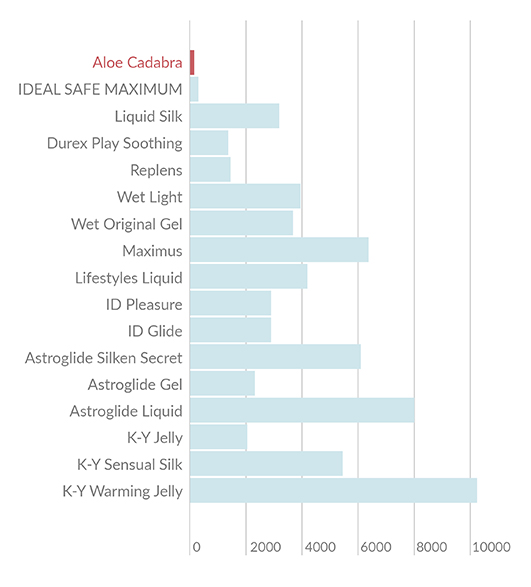What is Osmolality?
What You Need to Know
Article by: Dr. Laurie Steelsmith & Alex Steelsmith. Published here with permission from Sexual Wellness News®
 Here’s some important news that many sexually active people need to know about:
Here’s some important news that many sexually active people need to know about:
New evidence suggests that many personal lubricants sold on store shelves today may have the potential to damage your sensitive genital tissues, and may increase your risk of contracting sexually transmitted infections (STIs), even HIV.
These disturbing findings are from the World Health Organization, Johns Hopkins University and other leading institutions where they’ve been studying something called osmolality.
It turns out that most lubricants—including 15 brands listed below—have high osmolality ratings, meaning they’re packed with more sugars and salts than are found naturally in our own bodies.
 Instead of moisturizing your skin, high-osmolality lubricants can actually make it drier.
Instead of moisturizing your skin, high-osmolality lubricants can actually make it drier.
In trying to reach equilibrium (think back to junior high osmosis class), they actually draw water out of surrounding tissues—for example, your vaginal cells.
When that happens, says the University of Pittsburgh’s Dr. Charlene Dezzutti,
“the cells shrivel up to the point that they look like little raisins under a microscope.”1
That can cause chafing, which in turn may weaken your body’s defenses against bacterial and yeast infections, and STIs like herpes, chlamydia, human papilloma virus, and HIV. But before you toss out your lubricants, let me tell you what I advise my sexually active patients:
Don’t stop using personal lubricants altogether, but be choosy. The right lubricants can help protect your sensitive tissues and make them less vulnerable to damage, infections, and disease. They can minimize the risk of condom breakage. And, for many people, they’ll make sex more comfortable and pleasurable.
Which lubricants are safest?
Read the label, and make sure your lubricant is:
- Made of natural ingredients – your private parts are no place for harsh, synthetic chemicals.
- Water based – condoms used with oil-based lubricants are twice as likely to break.2
- Free of propylene glycol and glycerol – never, ever use a lubricant with either of these ingredients as they are the key drivers of high osmolality.
In my recent book, Great Sex Naturally; Every Woman’s Guide to Enhancing Her Sexuality Through the Secrets of Natural Medicine, I describe several lubricants that meet these criteria.
At the top of the list is Aloe Cadabra, the first personal lubricant certified to strict new NSF organic standards. As its name suggests, it’s made of 95 percent organic, natural aloe vera—the same soothing ingredient found in many premium skin lotions. Aloe Cadabra has an outstanding osmolality rating of just 172 mOsm/kg—close to the vagina’s natural osmolality of 260 – 290 mOsm/kg.
How do conventional personal lubricants compare?
As you can see from this chart, most have ratings that range from very high (e.g., 2,000) to off the charts (8,000 and above)2. That’s several times higher than what’s considered ideal for genital tissue health.
Personal Lubricant Osmolality
High-Osmolality Lubricants can dry out your tissue and make it more susceptible to infection and disease. Of these brands reviewed, only Aloe Cadabra falls within the safest level (measured in mOsm/kg).
SOURCES: The World Health Organization, Pacific Bio Labs, and U.S. National Institutes of Health
- K-Y Warming Jelly has an osmolality rating of 10,300—more than 30 times the body’s normal levels. In rodent testing, it was shown to increase the rate of herpes transmission more than seven-fold.1
- Astroglide personal lubricant products may also have high osmolality ratings; one rates as high as 8,064. In an in vitro test by the Population Council, four brands of Astroglide were shown to accelerate HIV transmission3.
- ID Glide has an osmolality rating of 2,901, and in a human study conducted at Johns Hopkins University was shown to cause significant tissue damage when used during anal sex1.
Until conventional lubricant companies reformulate their products in a way that reduces their osmolality ratings, here’s what I suggest:
- Stick with natural, organic lubricants like Aloe Cadabra. Besides having a low osmolality rating, it’s also pH balanced to your body, and contains no parabens, glycerins, or other risky chemicals. You can find Aloe Cadabra at CVS and many other stores where conventional lubricants are sold.
- Share this news with your partner, friends, and loved ones. Let them know that ingredients in many personal lubricants on the market may increase their risk of STIs, and that there are wonderful alternatives that can support the integrity of their delicate genital tissues. Tell them that by choosing the right products they can maintain their sexual wellness.
References:
1. Wolf, Lauren K. “Studies Raise Questions About Safety Of Personal Lubricants” Chemical & Engineering News, Volume 90 Issue 50 | pp. 46-47, December 10, 2012
2. World Health Organization, “Use and procurement of additional lubricants for male and female condoms” report, Geneva, Switzerland, 2012
3. Begay O, Jean-Pierre N, Abraham CJ, et al. “Identification of personal lubricants that can cause rectal epithelial cell amage and enhance HIV Type 1 replication in vitro”. AIDS Research and Human Retroviruses, 2011, 27(9):1019-1024


